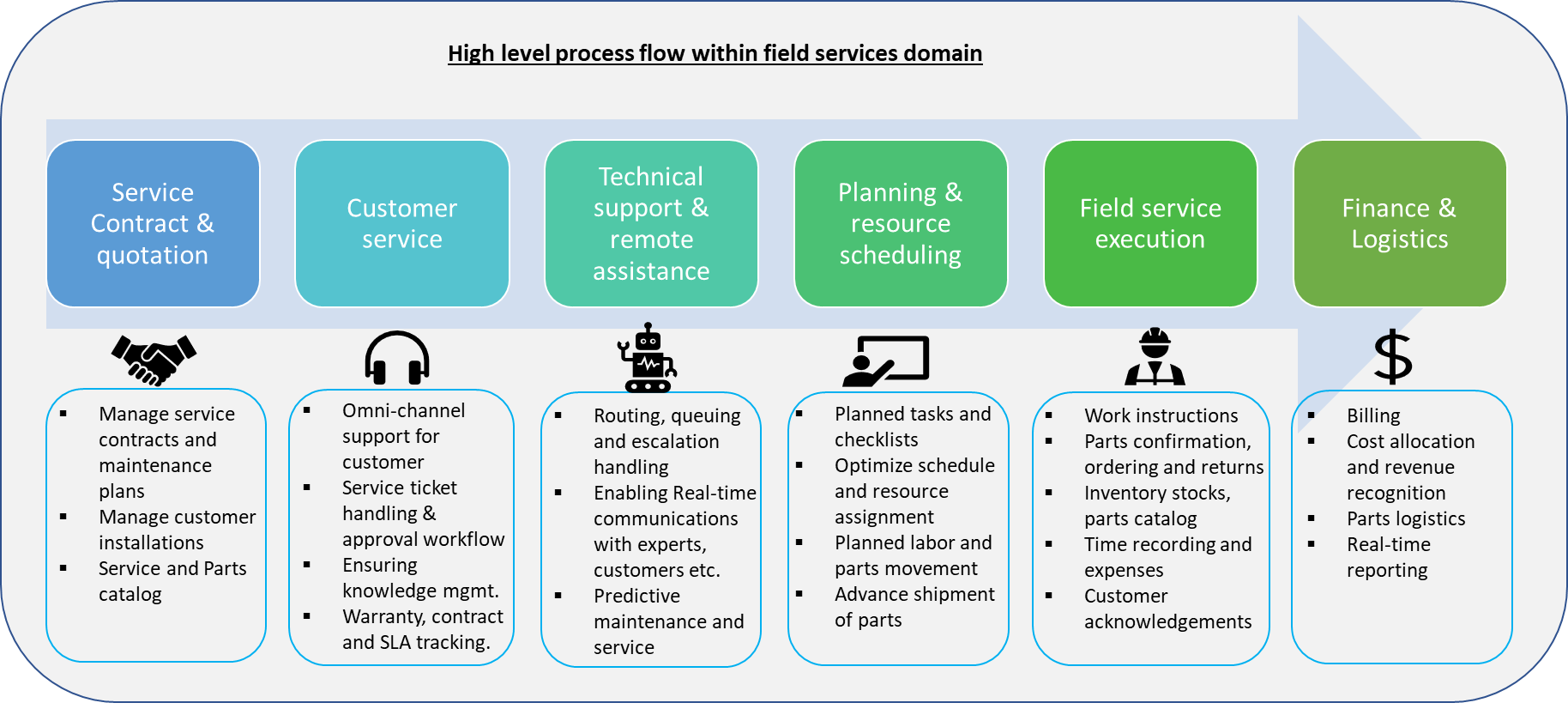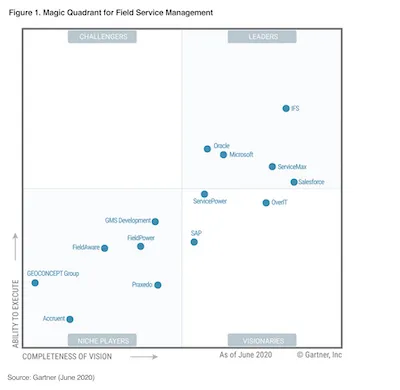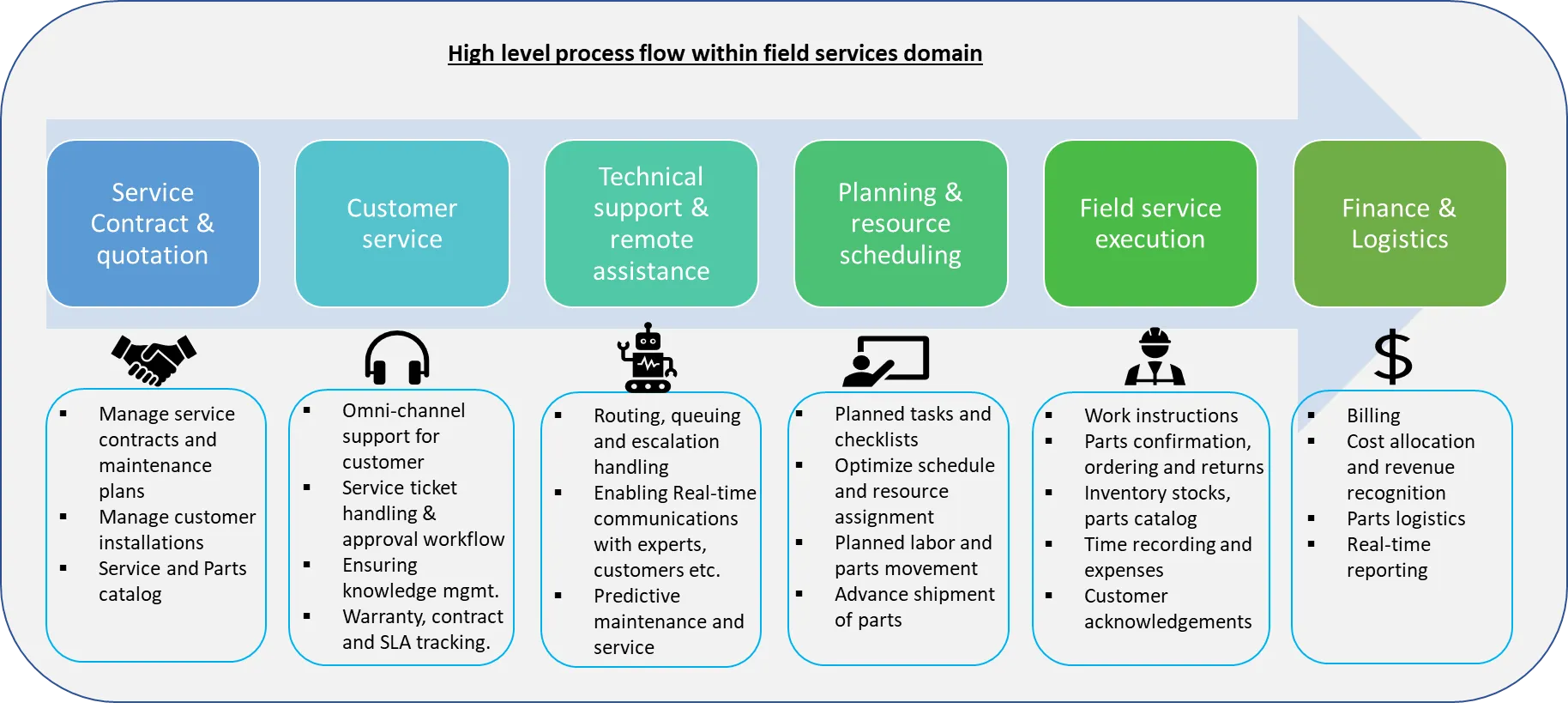Field services management in the utilities industry
Blog: Capgemini CTO Blog
Field services management
Field service management (FSM) is the system for coordinating field service operations. It includes scheduling work orders, dispatching service technicians, tracking labor hours and job statuses and invoicing the completed job. However, field service management is much deeper and encompasses every aspect of service delivery. Effective people management and processes are necessary to make the field service efficient. This function is at the core for any organization that services clients, e.g. construction and repair of utilities infrastructure, mining, industrial and heavy engineering, HVAC industries, gas utilities, etc.
The global field service management market size was valued at USD3.12 billion in 2018, and is projected to reach USD10.81 billion by 2026, growing at a CAGR of 16.9% from 2019 to 2026 (Source: AlliedMarketResearch)
Field services are integral to ensure business continuity of the utilities industry. In the utilities industry, field workers are responsible for infrastructure construction, maintenance, restoration, and customer services. The constant movement of service agents on and off the field, high-risk maintenance work, extreme weather, and remote location work assignments are not rare. Hence, efficient communication and safety precautions are essential. Often, service agents directly interact with customers and hence they are the representatives of utility service providers.
High-level processes within the field services function in organizations
Business processes involved in the field services area are:
- Service contract and quotation
- Customer service
- Technical support and remote assistance
- Planning and resource scheduling
- Field service execution
- Finance and logistics.

FSM begins with planning, execution, and confirmation of services. These processes are also linked with service sales, customer relationship management, finance and billing, engineering and manufacturing for information such as parts design, inventory, maintenance/work instructions. FSM is also linked with human resources systems due to involvement of labor in the field.

Current approach and challenges in the field service management
Currently in the utilities industry, field service management is mostly paper-based. The back office manages the work plan for its service representatives. Last-minute order placement, order cancellation, or changes in work assigned are frequent since they are managed manually. These factors negatively impact employee productivity.
Field workers must know their schedule well in advance and have clear visibility to the requirements such as parts availability, weather factors, work manuals/guide, work instructions, work orders, customer information or any other special requirements, etc. However, the current system of manual communication with field workers/service representatives is creating gaps in efficient communication, incomplete information, and lack of safety precautions while adding customer dissatisfaction. Hence, it is important for organizations to automate field service management.
The data required to execute the services work needs integration with several systems. And most of this data is captured through paper or mobile devices and the approach is siloed today. Further, if the field technicians need to switch between different applications to receive and update the information on field, it will result in more errors and would reduce their efficiencies.
Hence, a well thought automation in field services management function is critical.
Automation in the field services management
Today many organizations provide their field engineers with mobile devices for accessing information. However, this data needs to be accurate. Having a good FSM system in place along with integration to the ERP systems can break the barrier of siloed information and make FSM more efficient and effective. This, along with the use of emerging technologies, can take automation to the next level and make the information available both online and offline.
Good FSM solutions should have the capabilities listed below, either in a single platform or integrated across systems:
- Order management and execution planning & scheduling of service orders
- Location tracking for field service technician and route optimization.
- Enablement of time tracking while on the job and maintaining the logs
- Access to knowledge repository for engineers on the job.
- Inventory management and availability of parts on time
- Work and maintenance manuals
- Integrated payment systems for generating invoices.
- Portals for customers to access regular updates and raise service orders.
- Compliance processes
- Worker health and safety
Below are some of the ISVs that are enabling field service management modules in their portfolio:
- Microsoft Dynamics 365 Field Service
- Salesforce Field Service Management
- ServiceNow Field Service Management
- SAP Field Services Module
- Oracle Field Service Suite
Gartner’s 2020 report on FSM shows the market placement of different products by different vendors. This can give organizations a good overview of the software to choose.

In addition to the above FSM solutions, there are SAAS-based mobile workforce management (MWM) solutions as well. They provide a suite of tools, processes, etc. to schedule, monitor, track and analyze the performance of field workers as they deliver services on site. These solutions are closely linked with the MWM vs FSM
The key difference between MWM and FSM is that MWM optimizes processes around human assets, while field service management optimizes processes around physical assets/field support. If your goal is to optimize the customer journey, the scheduling process, or the execution of your mobile teams’ daily work, then a mobile workforce management system is ideal. If your goal is to optimize the installation, maintenance, or repair of physical products, a field service management tool is the right choice.
Potential opportunities for digital transformation in field services
In addition to implementing FSM solutions, organizations should consider digital transformation to achieve productivity and mobility improvement of technicians.
Some of the potential opportunities for digital transformation in this function are:
- Process automation – Eliminating paper-based processes and providing information on mobile/tablet/wearable glass or other portable devices to engineers
- Predictive maintenance – Using AI/ML capabilities to conduct predictive maintenance of utilities infrastructure
- Remote service assistance – Using AR capabilities to enable remote service assistance for field engineers along with expert connect using chatbots,
- Remote training – Enabling remote training capabilities for engineers using VR-based training content.
In order to achieve positive return on investment, requires an understanding of the critical task, information and support required by technician on the field while performing the job.
Some of the important data elements that a field technician needs on the field to carry out their tasks are:
- Work order information
- Inventory and parts information
- Communication with customers
- Maintenance procedures
- Knowledge base
- Image and video capture
- Expert advice.
Conclusion
A well-planned field services transformation program with clear goals/vision definition will help an organization transform this function. Assessment of as-is field service processes and technology landscape followed by correct tool selection would help create a roadmap for implementation.
This article is co-authored by Pushpa Bhagwat.
